 The Internet yukked it up this past year over the stone-washed camp of the blog Awkward Family Photos. It became an instant meme, and even led to a forthcoming book blurbed by no less a joker than Judd Apatow. If the phenomenon got mileage from the bad ‘dos and goofy pleats of decades past, at its heart lay the simple pleasure of bringing our own frames of reference to intimate portraits of strangers.
The Internet yukked it up this past year over the stone-washed camp of the blog Awkward Family Photos. It became an instant meme, and even led to a forthcoming book blurbed by no less a joker than Judd Apatow. If the phenomenon got mileage from the bad ‘dos and goofy pleats of decades past, at its heart lay the simple pleasure of bringing our own frames of reference to intimate portraits of strangers.
Duke Digital Collections published the Hugh Mangum Photographs collection a few years ago, and while it inspires maybe a more dignified response and less of the beverage-snorting amusement, it affords many of the same simple pleasures. Mangum was an itinerant portrait photographer who set up shop along rail routes in North Carolina, Virginia and West Virginia. As Karen Glynn, our Visual Materials Archivist wrote, “Mangum photographs are distinctive for the level of comfort exhibited by his subjects in front of the camera.” Using inexpensive negatives, he took numerous shots of his subjects, capturing them in relaxed poses.
This week we added images of the 688 negatives – many of which contain multiple exposures – to our flickr account. We hope they will inspire appreciation, but also closer examination. We would like to identify the subjects of these photographs, and enhance our frame of reference for them. Please help us if you can, by adding your comments to the versions of the photos there.
As I uploaded the photographs to flickr, I took a few moments to re-connect with this collection, one of the first digitization projects I worked on at Duke. I took particular interest in the small number of outdoor shots. In nearly all of Mangum’s photos the setting is the studio, but forty of them are exterior shots. Our metadata notes the distinction, so it’s easy to pull them up in a search. This link will list them all on a page, but I recommend selecting the 3-d wall option to view them in cooliris.
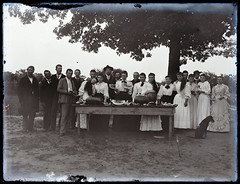 Of the forty, three are shots of structures. There are a few of people on horses, and one of a man mostly obscured by a horse. There’s a watermelon party with the celebrants arranged practically shoulder to shoulder and the impressive watermelons turned to full oblong effect, including the slices, to present a scene of pronounced horizontality. Then there are a number of shots of large groups posed directly outside their dwellings or possibly schoolhouses. Some of them are clearly families, not at all awkward, presenting themselves in simple array on their front porches or directly before their homes.
Of the forty, three are shots of structures. There are a few of people on horses, and one of a man mostly obscured by a horse. There’s a watermelon party with the celebrants arranged practically shoulder to shoulder and the impressive watermelons turned to full oblong effect, including the slices, to present a scene of pronounced horizontality. Then there are a number of shots of large groups posed directly outside their dwellings or possibly schoolhouses. Some of them are clearly families, not at all awkward, presenting themselves in simple array on their front porches or directly before their homes.
 Two show what is apparently the same child with a group of astonishing, fluffy, white chickens. In N402, the birds gather before the child in a field of high grass, in a scene that seems to modulate between ominous and ridiculous as I contemplate it. The chickens so impressed Mangum that he took a third exposure of them without the child.
Two show what is apparently the same child with a group of astonishing, fluffy, white chickens. In N402, the birds gather before the child in a field of high grass, in a scene that seems to modulate between ominous and ridiculous as I contemplate it. The chickens so impressed Mangum that he took a third exposure of them without the child.
But there is another category that intrigues me. In these shots the subjects have dressed in perhaps their finest clothes, and posed in natural settings that I would not characterize as picturesque. In a few of them, they have even positioned themselves in crude little brushy patches, or on logs.
 It’s not difficult, for example, to understand the staging of N400, which shows men from a long distance standing on an impressive formation of rocks. If I lived near, or work around, or otherwise encountered those rocks, I might have someone take a picture of me on them, and post it on Facebook. “Nice rocks,” someone would comment.
It’s not difficult, for example, to understand the staging of N400, which shows men from a long distance standing on an impressive formation of rocks. If I lived near, or work around, or otherwise encountered those rocks, I might have someone take a picture of me on them, and post it on Facebook. “Nice rocks,” someone would comment.
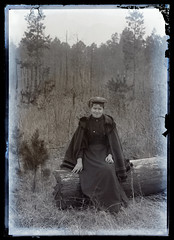 But it’s harder to know what to make of N326. The subject wears dark, dressy clothes, and she sits on a very undistinguished, rotting log with a scraggly expanse of new-growth forest behind her. If I paid a portrait photographer to make a keepsake of my image, I can’t imagine choosing that backdrop.
But it’s harder to know what to make of N326. The subject wears dark, dressy clothes, and she sits on a very undistinguished, rotting log with a scraggly expanse of new-growth forest behind her. If I paid a portrait photographer to make a keepsake of my image, I can’t imagine choosing that backdrop.
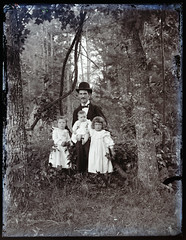 Even more curious are the shots where people have posed themselves actually sitting or standing in patches of brush. N474 shows a proud papa on a log covered in ivy, so it’s somewhat more interesting than the previous log. A baby bounces on his lap, and children stand at his sides. The brush fills in around them. The askance gazes of the children and the slight blur in the exposure suggest that it was an outtake.
Even more curious are the shots where people have posed themselves actually sitting or standing in patches of brush. N474 shows a proud papa on a log covered in ivy, so it’s somewhat more interesting than the previous log. A baby bounces on his lap, and children stand at his sides. The brush fills in around them. The askance gazes of the children and the slight blur in the exposure suggest that it was an outtake.
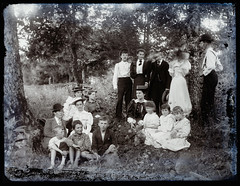 Similarly, the family in N469 has not yet settled into a pose. They stand in a patch of brush, and by all appearances the threat of poison ivy does not concern them.
Similarly, the family in N469 has not yet settled into a pose. They stand in a patch of brush, and by all appearances the threat of poison ivy does not concern them.
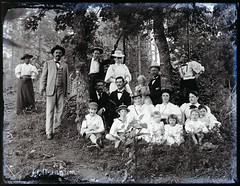 Perhaps the most interesting of these outdoor shots is N472, where the brush patch seems to delineate a racial/class distinction. It appears to have been taken in the same spot and and feature the same male subject as N474 above. It’s one of the few shots in the collection that features blacks and whites posed together. My own frame of reference about racial attitudes in the South during the period would probably lead me to speculate that the black woman in the background was a domestic servant of the family. But her secondary status seems reinforced by the simple fact that she has posed outside the brushy patch with the rest of the group.
Perhaps the most interesting of these outdoor shots is N472, where the brush patch seems to delineate a racial/class distinction. It appears to have been taken in the same spot and and feature the same male subject as N474 above. It’s one of the few shots in the collection that features blacks and whites posed together. My own frame of reference about racial attitudes in the South during the period would probably lead me to speculate that the black woman in the background was a domestic servant of the family. But her secondary status seems reinforced by the simple fact that she has posed outside the brushy patch with the rest of the group.
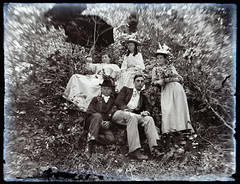 In N478, a group of young people gather and lounge in the center of a cluster of leaves and branches. The blurring of the foliage that surrounds them gives the image a trippy quality. One woman actually pulls a branch down in front of her, identifying herself even further with the vegetation.
In N478, a group of young people gather and lounge in the center of a cluster of leaves and branches. The blurring of the foliage that surrounds them gives the image a trippy quality. One woman actually pulls a branch down in front of her, identifying herself even further with the vegetation.
While it’s tempting to apply Awkward-Family-Photos-style snark to these people we don’t know, I’ll leave that to others. I don’t know enough about Mangum, or about portrait photography of the period, to speculate if it was just his style, or a convention of the time, or if some other explanation lies behind this sample size of about half a dozen. I do hope the people in the photos checked for ticks as they changed out of their dress clothes.


Love this post, Will. My grandparents were born and raised in Pulaski. I’ve asked my grandfather to take a look at the Flickr collection and pass it along to friends and family, so maybe you’ll get some responses!
Thanks on all counts, Elizabeth.
great article. I always wondered why “those people” looked so wooden; this suggests a behind-the-scenes view.
I’ve seen this tendency in other period photos. Maybe it’s to do with the custom of wreathing things decoratively, including vines around picture frames. People still often seek a leafy backdrop for portraits. Rough brush isn’t quite as elegant as vines or leaves, but..it’s green…